*In collaboration with Mauro da Rosa Sirtoli
Solar energy has traditionally been configured to be installed on large tracts of land or on building roofs.
Since 2010, new spaces have become a solid option when it comes to installing solar panels: water. Ponds, lakes and reservoirs have recently been considered as a suitable place to deploy solar power plants, especially in countries where land is a scarce resource.
Floating solar plants are interesting in places where high population density can make the cost of a piece of land extremely high or when there is no suitable land for traditional type installation.
Floating installations typically consist of a set of solar panels mounted on a fixed-tilt metal structure that is mounted on floating rafts that are placed on salt or fresh water surfaces.
These floating platforms can be anchored to the bottom of reservoirs, lakes or directly to the nearest shore. These anchors allow the floating plant to be fixed in a certain location, allowing enough flexibility and play to adjust its position with the movement of water, waves or tides.
The DC current from the panels is generally transported via underwater cables to the nearest shore where the inverters are located (applicable to central inverter configurations). If the floating solar plant uses string inverters, these will be located close to the strings, on the floating structure.
After the inverters, the current passes through the transformer, which is normally a voltage step-up. Finally, using a transmission or distribution line, the energy is injected into the grid or will directly feed a consumption center (loads).

Floating solar plants have some advantages over ground-mounted ones, such as:
- They use existing transmission infrastructures when installed close to hydroelectric plants;
- They present better performance due to the cooling effect of the water and less impact of dirt on the panels;
- They can be used close to demand centers and, as mentioned previously, in areas that would normally be idle;
- They present good value for money. Advantages in performance may vary depending on several factors, but as studied so far, these advantages outweigh the increase in expenses (CAPEX) of this type of solar installations;
- They reduce the evaporation of water from reservoirs, which is especially interesting in areas where water is used for agriculture, water supply to the civilian population or any case where fresh water is a limited resource;
- Reduced or zero expenses on civil works and earthmoving, which in some cases can have a major environmental impact.
Growth of the floating plant market
With the rapid growth of the photovoltaic industry in general, new applications have emerged. Floating installations began to be installed in early 2008 with some pilot projects, but were not relevant until 2016, when the annual installed capacity exceeded 100 MWp worldwide.
Nowadays, floating installations are still emerging compared to ground-mounted solar PV, but their growth is exponential mainly leveraged with the continuous decrease in costs of solar panels, inverters and remaining BOS (balance of system).
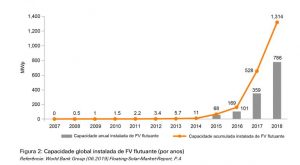
Floating installations larger than 1 MWp began to be installed in late 2013 and early 2014, particularly in Japan and Korea, where land is a valuable asset for real estate development.
Larger solar plants (above 50 MWp) became a reality in China at the beginning of 2018 and are currently the leader not only in ground-mounted solar plants, but also in floating installations.
Most of the installations carried out and under development are in freshwater, mainly due to the ease of installation and the lower number of technical complications compared to saltwater locations (corrosion, dynamic forces on structures, environmental conditions, etc.).
Although floating solar plants at sea or in coastal/marine areas pose additional complexities, these are becoming more popular, particularly for island territories where inland land cannot or is not desirable to be used for solar purposes.
Key challenges for coastal or offshore floating photovoltaics include, but not limited to:
- Greater dynamic load on floating ferries mainly due to waves, tides and winds. Need for more resistant construction capable of withstanding these loads for long periods of time (the useful life of solar plants tends to be around 20 years);
- The anchoring of floating devices/rafts also requires higher requirements in terms of mechanical and dynamic strength. There may be additional difficulty when the anchors need to be underwater at a certain depth;
- Salt fog is present in the air, creating an aggressive corrosion environment, affecting the durability of all components of the solar plant, in particular metal parts;
- Interaction between animals and marine organisms that can interfere with the functionality of the entire system;
- O&M costs tend to be higher in marine applications than in freshwater applications, mainly due to the higher failure rate in salty environments and the need for more preventative maintenance activities;
- The biggest uncertainties of floating marine applications are long-term costs, site performance, and durability of materials and components.
In terms of policy and special regulation, it is important to mention that floating solar plants in fresh or salt water are still embryonic compared to ground-mount systems.
Most of the process is similar or the same as centralized generation, but some challenges are encountered in obtaining environmental licenses and authorizations, water use rights or “water rental” prices.
Floating solar plants may not need additional incentives such as FIT (Feed in Tariffs), auctions, tenders or any other mechanisms, but it is certain that the initial project may entail some additional cost due to “technology risks” or new products specific to such an application that its costs may be reduced when the use of this type of plant is expanded.
Market opportunities seem limitless due to the amount of water available on the planet. However, floating solar potential is not only determined by available space, but also by future energy needs, as well as the market share that floating plants could achieve, competing with other technologies and locations.
Financial Considerations in Floating Solar PV Projects
The following table presents an assessment of the real potential for floating photovoltaic generation in the coming years (from 2020 onwards).
Capacity (peak power) and power generation potential of floating solar plants in artificial freshwater reservoirs, by continent
This table assumes an average yield (kWh/kWp) for all installations with the same GCR (Ground Coverage Ratio) or WCR (water/reservoir coverage rate), which may be different depending on location . In any case, as an estimate, the table above provides an accurate enough insight into the potential of the applications.
The cost of floating solar plants is a little higher when looking at their initial investment compared to their similar size and location on land.
The higher costs are mainly due to the floating platform (compared to ground-mounted profiles), the anchoring elements (not required for ground-mounted installations) and the higher technical demands of some components due to high humidity and corrosion.
Furthermore, if the floating installation is located in coastal areas, additional costs need to be considered due to higher component specifications. Capital expenditure for a floating system varies between R$ 4.584 and R$ 7.45 per watt peak, including transformer and transmission costs to the tap point.
While these numbers are tentative, they may vary depending on the project location, types of floats used, depth of its anchoring mechanism, and size of the entire system.
There can be savings in installing floating systems, as well as ground-based systems, with increased scale. At the moment, floating installation has similar costs to rooftop systems.
The chart below shows the capital expenditure of a floating system depending on regions and sizes (Values in US$/Wp).
Costs of floating solar plants in some locations around the world between 2014 and 2018.
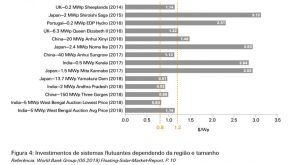
What is very interesting to analyze is that while the initial investment for the large-scale floating system is greater than that of its land-based counterpart, the final LCOE (levelized cost of electricity) would be comparable, considering the higher yield of floating systems. .
The expected increase in yield or PR (performance ratio) is between 5% to 10% compared to ground-mounted solar systems. The following table, prepared by SERIS (Solar Energy Research Institute of Singapore) shows the comparison of LCOE between the same solar plant (50 MWp) ground-mounted and floating in three different locations or regions.
Comparison of LCOE between 50 MWp ground and floating solar plants, by region
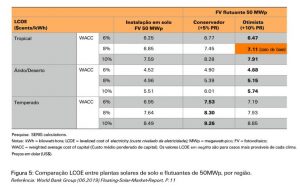
It can be seen that with an increase in the performance rate (PR) the difference in LCOE between a given floating installation and one on land varies between 3.52% and 3.53% between different locations at a WACC (Weighted Average Cost of Capital) of 6% and between 4.21% and 4.52% with a WACC of 10%.
The difference is not significant, especially at the stage where floating photovoltaic systems appear to be in their embryonic phase. It even seems logical that, with the massive adoption of floating systems, their CAPEX could drop even further and become cheaper than ground-mounted systems.
Furthermore, assuming that surface water in some regions could become even cheaper than available land, floating photovoltaic systems could even become, in the medium term, even more attractive than traditional large-scale solar plant services. scale.
Check out the next ones events in the solar energy sector and stay informed about the renewable energy generation of the future!
Conclusions
Within the photovoltaic industry, a new, fast-growing branch has emerged in the form of floating systems. These types of solar plants provide a new scenario for renewable energy, which would allow certain countries to have a cleaner energy mix with less environmental impact, while benefiting from idle land.
Reducing land use is the main attraction of floating solar energy, enabling real estate expansion or the use of land for agriculture.
When all these benefits are combined with an additional production yield of 5% to 10% compared to soil systems, the LCOE for floating systems has values close to those obtained with a soil plant.
This fact makes floating plants much more attractive, especially considering that these applications are still in a very early stage of use.
Discover the Weidmüller combiner boxes, special for floating solar plants. Find out more about the photovoltaic solutions from Weidmüller.
* Mauro da Rosa Sirtoli is an Electrical Engineer with a specialization in Electronics and Telecommunications (PUCRS). At the beginning of 2019, he joined Weidmueller Brasil as Field Sales Engineering at the South Branch, serving accounts in Porto Alegre and the region. As of June 2021, he assumed responsibility for the Renewable Energy department, working mainly on StringBox supply projects for centralized generation, negotiation of retail contracts for microgeneration boxes and commercial support for the Wind Solutions market.
The opinions and information presented are those of the author and do not necessarily reflect the opinion of Canal Solar.


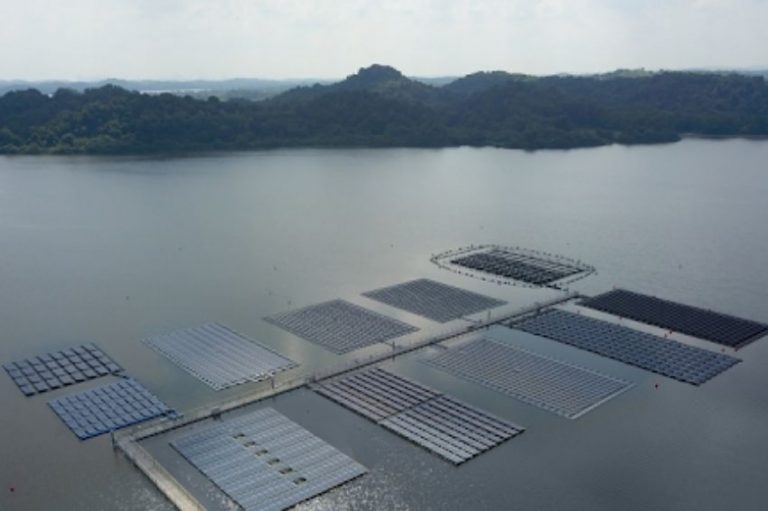

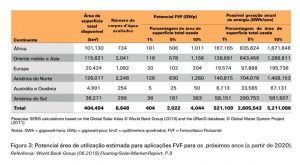













One Response
Dear good afternoon, which publication guides the installation of photovoltaic panels near rivers, lakes and the like?